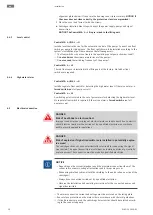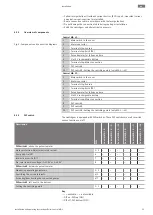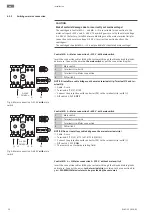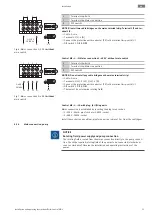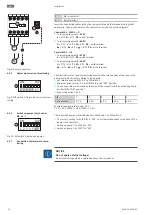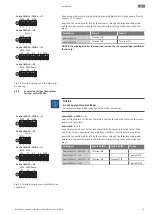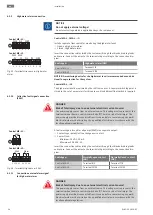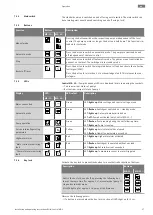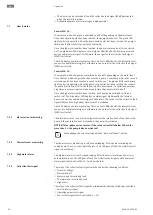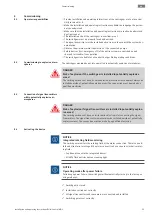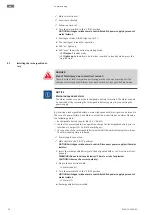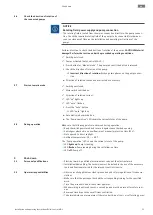
Installation
en
Installation and operating instructions Wilo-Control MS-L
17
ƒ
If there has been water ingress or condensation has formed, have all the electronic
components tested for correct function. Contact customer service!
6
Installation
ƒ
Check the switchgear for damage caused during transport. Do
not
install defective
switchgears!
ƒ
Observe the local guidelines for the design and operation of electronic controls.
6.1
Personnel qualifications
ƒ
Electrical work: A qualified electrician must carry out the electrical work.
ƒ
Installation/dismantling: The technician must be trained in the use of the necessary
tools and fixation materials for the relevant construction site.
6.2
Installation types
ƒ
Wall fixation
6.3
Operator responsibilities
ƒ
The installation location is clean, dry and free of vibration.
ƒ
The installation location is overflow-proof.
ƒ
The switchgear is not exposed to direct sunlight.
ƒ
Installation location outside of potentially explosive atmospheres.
6.4
Installation
DANGER
Risk of explosion if the switchgear is installed in potentially explosive
areas!
The switchgear does not have its own explosion protection class and must always be
installed outside of potentially explosive areas! The connection must be made by a
qualified electrician.
ƒ
Level sensor and connection cable provided by the customer.
ƒ
While laying the cables, ensure that there is no tension, no kinking and no pinching
that could damage the cable.
ƒ
Check the cable cross-section and length for the routing type chosen.
ƒ
Seal unused threaded cable glands.
ƒ
Ensure that the following ambient conditions are adhered to:
–
Ambient/operating temperature: -30 … +60 °C
–
Relative humidity: 40 … 50 %
–
Max. relative humidity: 50 %, non-condensing
6.4.1
Basic advice on fixing the
switchgear in place
Various structures can be used for installation (concrete wall, mounting rail, etc.). For
this reason, the fixation material for the relevant construction must be provided by the
customer and the following information must be observed:
ƒ
To prevent cracks in the masonry and chipping of the construction material, ensure
sufficient clearance to the edge of the structure.
ƒ
The depth of the borehole depends on the length of the screws. Drill the borehole
approx. 5 mm deeper than the screw length.
ƒ
Drilling dust impairs retention force. Always blow the borehole clean or vacuum it
out.
ƒ
Do not damage the housing during installation.
6.4.2
Installation of switchgear
Attach the switchgear to the wall with four screws and wall plugs:
ƒ
Max. screw diameter: 4 mm
ƒ
Max. screw head diameter: 7 mm
‡
Switchgear is disconnected from the mains and is voltage-free.
‡
“LS” version for lifting units: There is a socket available within a radius of 1 m
around the switchgear.
1. Mark boreholes at the installation site.
- drilling distances (W×H) MS-L 1: 129×238 mm
- drilling distances (W×H) MS-L 2: 288×200 mm
2. Drill and clean the mounting holes in accordance with the specifications of the fix-
ation material.
3. Loosen the screws on the cover and open the cover at the side.
4. Attach the lower part to the wall with the fixation material.
Check the lower part for deformations! Realign deformed housing (e.g. by placing
















